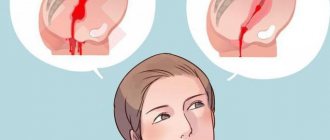The second stage of labor is the lowering of the fetal head along the planes of the pelvis and pushing. define the signs as follows:
- opening of the cervix by 10-12 cm - using a vaginal examination, this can be done by a doctor or midwife;
- pushing, while during a contraction the woman has a desire to push something, as if with severe constipation, she is looking for support for her hands, her facial expression changes compared to the first period, during pushing the woman in labor reflexively holds her breath.
As soon as the baby is fully born, the next period begins.
The course of the second stage of labor implies that the baby’s presenting part (usually the head) enters the pelvic cavity and then moves along this “narrow tunnel”. At the same time, he makes turns to enter and exit with the minimum dimensions of the head and body, without injuring himself and his mother. The child experiences stress, and often at this time various complications may occur that require immediate medical attention.
As soon as the baby passes the main planes formed by the pelvic bones, his head begins to appear from the genital slit during the next push. During the quiet period, it again goes somewhat deeper into the pelvis. So for a while. During the next attempt, the crown of the head is no longer hidden, but is fixed at the exit from the vagina. With subsequent contractions of the uterine muscles, the entire head, shoulders and arms, torso, and legs are gradually born.
The normal duration of the second stage of labor for first-time mothers is no more than two hours, for repeated births - no more than an hour. With induced labor, the criteria are halved. A longer course of the second stage of labor is fraught with serious complications for both the mother and the fetus.
Managing the second stage of labor requires great responsibility on the part of the doctor and midwife. The woman is initially still in the prenatal ward. After each contraction, it is necessary to listen to the fetal heartbeat for timely diagnosis of complications. As soon as the baby’s head emerges and emerges from the genital slit, the woman must be transferred to the delivery room itself and placed on a special chair. If the birth takes place vertically, it is convenient to sit down.
Doctor listening to fetal heartbeat
It is important to breathe properly while pushing . To do this, you just need to listen to the command from the midwife or doctor - they will tell you. Breathing should be as follows:
- when a contraction begins, you need to take a deep breath and hold your breath;
- at the peak of the contraction, push as hard as you can, but it is important to push “not in the face”;
- uterine contractions usually last about three minutes, and you need to push 5-6 times per contraction;
- as soon as the contraction ends, you need to exhale and breathe calmly, restore strength until the next attempt.
At the beginning of the second stage of labor, there is still a chance in an emergency to end the birth by cesarean section. As soon as the fetal head has dropped lower to the pelvic floor, labor can be accelerated if necessary only with the use of obstetric forceps or a vacuum extractor.
Bleeding is more common in the first and third periods. In the second stage of labor, as a rule, this is placental abruption or uterine rupture along the scar. This is an indication for operative delivery.
Fetal hypoxia is the most common complication. Oxygen is supplied to the fetus through the placenta through the vessels of the umbilical cord. If its loops are clamped somewhere, there is a sudden cessation of oxygen supply. At the same time, the baby’s heartbeat begins to suffer - the rhythm slows down. If this is detected, it is necessary to complete the birth as soon as possible - either a caesarean section, or forceps/vacuum extractor are applied. Untimely assistance can lead to the death or severe disability of a child , for example, the development of cerebral palsy, mental retardation and other similar conditions.
Clinically, a narrow pelvis is diagnosed at the beginning of the second stage of labor. If, against the background of complete opening of the cervix, the head does not advance, it means that it will not go away on its own and without complications. This is an indication for a cesarean section. At the same time, the size of a woman’s pelvis can be normal, just a large baby. Late diagnosis of this condition is always accompanied by serious injuries to the fetus, including its death.
Western classification according to the type of structure of the female pelvis
Shoulder dystocia is typical for large babies. Their head diameter is slightly smaller than the size of the chest, so the first one passes freely, but the shoulders get stuck. Shoulder dystocia is a serious complication of childbirth that is beyond the control of the doctor. To correct the situation, sometimes it is necessary to fracture the collarbone so that the baby “climbs through.” It is often accompanied by acute hypoxia of the fetus and serious consequences for it in the future.
Prolonged labor is established if the duration of the second period is more than two hours and an hour for first- and multiparous women, respectively. This means that the baby was in one of the positions for a long time - obstetricians figuratively say “standing.” In this case, compression occurs on the tissues of the child (usually the head) and the woman in the area of the bladder and rectum, which is fraught with complications.
No less dangerous is rapid labor - very fast, in which the baby is born in a couple of attempts. In this case, the likelihood of injury to the tissues of the fetal head and soft tissues of the birth canal increases.
From the moment the fetal head is cut in, it is necessary to perform obstetric care for the second stage of labor . If this is a physiological birth, it is attended by a midwife, and the doctor only monitors it; any deviations are indications for the direct participation of an obstetrician-gynecologist. The essence of the obstetric benefit is as follows:
- At the beginning, the perineum is protected from tears - its tissues are stretched, the rapid advancement of the head is prevented, the woman is told when to “breathe out” the contraction and when to push hard.
- As the parietal tubercles erupt, it is necessary to regulate the advancement of the fetus and prevent rapid extension of the head.
- After the back of the head has appeared, you need to wait for the shoulders to “fit.” At this time, the woman is usually asked to breathe through the contraction.
- With subsequent attempts, it is necessary to correctly remove parts of the fetus, while trying to restrain the perineal tissue from tearing.
After the baby is born, the umbilical cord is treated. The original lubricant, if any, is removed. The baby is swaddled and placed on the mother's chest.
Read more in our article about the second stage of labor.
Signs of the beginning of the second stage of labor
The entire birth process is divided into three periods. The longest period corresponds to the preparation of the cervix for full opening. Then follows the second stage of labor - lowering the fetal head along the planes of the pelvis and pushing. The last period includes the separation of the placenta (“baby place”).
The signs of the second period can be determined as follows:
- opening of the cervix by 10-12 cm - using a vaginal examination, this can be done by a doctor or midwife;
- pushing - during a contraction, a woman has a desire to push something, as if with severe constipation, she looks for support for her hands, her facial expression changes compared to the first period, during pushing the woman in labor reflexively holds her breath.
As soon as the baby is fully born, the next period begins.
We recommend reading about the first stage of labor. From the article you will learn about the signs, phases and duration of the first stage of labor, its features in primiparous and multiparous women. And here is more information about the features of premature pregnancy.
Stages of labor: how a baby is born
The labor process is divided into three stages of labor : the first is “dilation” (dilation of the cervix), the second is “pushing” (pushing or straining) and the third is “birth of the placenta” (placenta and membranes).
The first stage begins when you feel the first uterine contractions (contractions), which lead to changes in the cervix, and ends when the cervix is fully dilated. This stage is divided into two stages: early labor (at this time your cervix gradually becomes thinner and dilated), active labor (the cervix dilates much faster, contractions become stronger, and the time interval between them rapidly decreases). The stage of active labor includes the so-called “transition period” - the period of time when the cervix dilates from 8 to 10 centimeters.
The second stage begins when the cervix is fully dilated and ends with the birth of the child. This stage is called pushing because at this time the woman has a strong desire to push, which allows her to “push” the baby out.
The third stage begins immediately after the baby is born and ends with the birth of the placenta and fetal membranes (the so-called “placenta”).
In obstetrics, there is no specific period for how long a woman should give birth - each woman is individual, so the variation in the duration of labor can be quite significant. But on average, labor (from the onset of contractions to the birth of the baby) takes from 10 to 24 hours. It should be noted that in women who give birth to their second and subsequent children (but only on condition that the previous birth was natural (that is, not a caesarean section!), labor progresses much faster than in first-time mothers.
Stage No. 1: “Dilation of the cervix”
First stage: “Early labor”
Once your contractions become regular and your cervix begins to gradually dilate, you can confidently say that you are in labor. During the early labor stage, your contractions will gradually become more frequent and stronger, and the interval between them will become shorter. By the end of this stage of labor, contractions will come every 5 minutes and last between 40 and 60 seconds.
Often contractions in the early stages of labor are virtually painless. It is true that sometimes early labor contractions are quite painful, but despite the severe pain, the dilation of the cervix may occur much more slowly than you would like.
likely be at home throughout the first stage of labor (unless your doctor tells you to go to the hospital immediately). You may even feel that slow walking provides pain relief. You can also take a warm bath, watch TV, or even take a nap between contractions.
Have you noticed an increase in mucous discharge from the vagina? Do they have a reddish tint? Don't worry - this is one of the signs of the onset of labor - the passage of the mucus plug. This phenomenon is completely normal, but if you see that the amount of blood in the discharge is increasing, then you better call your doctor! You should also do this if your amniotic fluid has broken or is leaking, even if you haven't gone into labor yet.
Are you wondering how long the early labor stage lasts? It is difficult to answer this question, since the duration of this period is very variable and largely depends on how mature the cervix was at the beginning of labor, and how frequent and strong your contractions are.
If you are in labor for the first time, or if your cervix is not mature enough or is not dilating well, this phase can last from 6 to 12 hours, although it can be shorter or longer. If the cervix is mature enough, or if this is not the first birth, then, most likely, the process of cervical dilatation will go much faster, and the early labor phase will not drag on for long.
The early labor stage ends when your cervix is about 4cm dilated - at this point your contractions will intensify and you will enter the second stage of the dilation stage - active labour.
Some tips for this period: be sure to drink as much fluid as possible so that you do not develop dehydration and your body can regulate your body temperature through sweating (if you don't drink, you won't sweat, and if you don't sweat, your body temperature will rise) . And remember to urinate frequently, even if you don't feel the urge to urinate. A full bladder can make contractions more difficult, and an empty bladder gives your baby more space in your birth canal, allowing him to move through it more quickly.
Second stage: Active labor
During the active stage of the first stage of labor, your contractions become much more intense, more frequent, longer, and stronger. As a rule, once your contractions become regular, painful, and occur every 5 minutes for an hour of contraction (with each contraction lasting about 60 seconds), then it is time to seek medical help! Call an ambulance immediately or go to the maternity ward!
Your cervix will now dilate faster, until it is fully dilated - up to 10 cm. The last part of active labor, when the cervix dilates from 8 to 10 centimeters, is called the transition or transition period (which we talk about We'll tell you a little below). Towards the end of active labor, your baby will begin to descend into the birth canal.
For many women giving birth for the first time, active labor lasts from 4 to 8 hours, although this period can be longer or shorter. The active phase tends to go faster if you have been given oxytocin (for example, to induce labor or make contractions stronger) or if you have had a vaginal birth in the past. If you have had an epidural anesthesia, or if you have a very large child, then this stage may be significantly delayed.
Almost half of women in labor during the active phase resort to drug pain relief, such as spinal, epidural or epidural-spinal anesthesia. But before you ask for a shot, remember that there are many non-drug ways to relieve pain during contractions - such as relaxation techniques, special breathing exercises, partner support, massage, which can help you as much as drugs! Please note that any anesthesia limits your ability to move and delays the birth process!
Transition period
The final part of active labor - when the cervix dilates from 8 to a full 10 centimeters - is called the transition period, because at this moment the transition to the second stage of labor . The transition period is the most intense part of the birth process. Contractions at this time are very strong, repeated every 2 - 2.5 minutes and last a minute or more, and women in labor often note that at this time they began to feel fever or chills. The transition period may take a few minutes, but can last several hours. But, if you have already had a vaginal birth in the past, then this period will end much faster for you.
By this time, your cervix is fully dilated and your baby has descended completely into your pelvic area. You may feel rectal pressure, similar to the urge to have a bowel movement. Some women at this moment begin to spontaneously push, as if wanting to “push out” the child, who has begun to strongly push the pelvic bones.
If you have an epidural, the amount of pressure you feel depends on how much medicine you were given and how low your baby went. If you wanted to be more involved in labor, ask for a reduction in the dose of medicine given through the catheter.
If you give birth without an epidural, you may become panicky and unsure of your ability to cope with pain during the transition. In such a situation, it will not be superfluous to support your birth partner, as well as perform some manipulations to relieve pain:
- 1. Massage - Some women feel pain relief from a light touch on their back, others from a gentle tapping, others from a strong massage, and some prefer not to be touched at all. Here everything depends only on your desire!
- 2. Changing Positions – Sometimes changing your birthing position will provide the relief you want! For example, if you feel very strong pressure in your lower back, then the “on all fours” position may well reduce the discomfort.
- 3. Compresses – a cool cloth placed on your forehead or a cold compress on your back can make a big difference, especially if you feel too hot or nauseous. If, on the contrary, you feel chills, then a warm compress can help.
On the other hand, since the transition period will concentrate all your attention, you may need to eliminate all irritating factors - conversations, music, and even your beloved man who has become your birth partner!
Stage No. 2: “Attempts”
Once your cervix is fully dilated, the second stage of labor —pushing and delivering the baby. At the very beginning of the second stage, the interval between contractions may increase slightly, which will give you the opportunity to rest a little during this time. Many women find second-stage contractions easier than they were in active labor because straining during contractions virtually eliminates the sensation of pain.
If your baby is already low enough in the pelvis, you may feel the urge to push at the very beginning of the second stage. But if your baby is still high, you likely won't feel the urge right away. The contraction of your uterus during contractions puts pressure on your baby, pushing him down your birth canal. Therefore, if everything is going well, you can simply wait a little while for the uterus to do its “work” and you feel the urge to push.
But in most maternity hospitals it is not customary to let the situation take its course, so the midwife or doctor delivering the baby tells the woman when to push in order to speed up the progress of the baby.
The baby’s progress through your birth canal can be quite fast if this is not your first birth, but it can also happen gradually (this is true for first-time women). With each contraction, your uterus, combined with the force you exert by contracting your abdominal muscles (that is, when you push), pushes down on the baby and continues to move it down the birth canal.
After a while, the perineal area (tissue between the anus and vagina) will begin to bulge with each thrust, and soon the midwife will see the baby's scalp. Now the urge to push becomes even stronger. With each strain, your baby's head will become more visible until it is fully visible. The pressure of your baby's head on your perineum can cause a strong burning or tingling sensation because the tissue of the perineum is greatly stretched at this time.
At some point, your doctor or midwife may ask you to push harder or weaker - this will gradually stretch your vagina and perineum, which will help avoid tearing the perineal tissue.
After your baby's head emerges, your doctor or midwife will suction any mucus and remaining amniotic fluid from your baby's nose and mouth, and if your baby has an umbilical cord around his neck, the doctor will untie the umbilical cord. During the subsequent contraction, the child’s shoulders appear one at a time, after which the whole body comes out. Your baby was born - and he notified everyone about it with his loud cry!
After the baby is born, the doctor will place clamps on the umbilical cord in two places and then cut it between these clamps. Usually at this moment, new mothers understand that childbirth is behind them and experience long-awaited relief! And with relief comes a lot of feelings and emotions - joy, euphoria, delight, tears of joy, love, tenderness...
As soon as a baby is born and enters an unfamiliar environment, he should be warmed and towel dried. If the birth went without complications and your baby is healthy and feeling well, then he will be placed on your chest. With this “skin-to-skin” contact (plus they will definitely cover the baby with a warm blanket on top!) the baby will not only be well warmed up, but will also not lose contact with his mother!
Without the use of epidural anesthesia, the average duration of the second stage of labor is about 20 minutes for multiparous women and about an hour for primiparous women. If the woman in labor has had epidural anesthesia, the second stage usually lasts longer.
Stage No. 3: “Birth of the placenta”
A few minutes after the baby is born, your uterus begins to contract again. The first few contractions separate the placenta from the uterine wall. When the doctor sees signs of the third stage of labor, he will ask you to push slightly to expel the placenta. For this, as a rule, one straining is enough, which is not difficult or painful. Many women even love the feeling they get when giving birth to an afterbirth! On average, the third stage of labor takes about 5-10 minutes.
After the placenta is delivered, the uterus contracts and becomes very hard. You can feel its upper part by pressing on the stomach near the navel. Your doctor (and then your nurse) will periodically check how your uterus is changing and massage it if necessary. This is important because the contraction of the uterus helps to clot the blood in the open blood vessels where the placenta was attached. If the uterus does not contract properly, you will continue to bleed from these vessels.
If you are going to breastfeed, you will be able to put your baby to your breast within the first hour. Breastfeeding and sharing the same room with your baby not only brings spiritual satisfaction, but also has a beneficial effect on your health. When your baby nurses, your body releases oxytocin, a hormone that causes your uterus to contract and help it stay firm and return to normal. If you do not want to breastfeed, you will be given intramuscular oxytocin immediately after birth.
Your doctor will look closely at the placenta to make sure it has been delivered completely. The doctor will then examine your birth canal and perineum to look for any tears that require stitches. If you have a severe tear or have had an episiotomy (perineotomy), be sure to numb the tear (incision) site with a local anesthetic before putting stitches. If you had an epidural, your anesthesiologist will remove the catheter from your back immediately after delivery. It only takes a second and doesn't hurt at all.
So you have gone through all the stages of childbirth ! Now you and your spouse can fully enjoy this special time when a little miracle has been born - your baby!
Related articles on the topic:
- Main signs of impending labor
- AIDS during pregnancy - will the child get infected?
TAKE THE TEST (8 questions):
HOW JEALOUS ARE YOU? (one more test!)
Course and duration of the period
The time during which the fetal head descends and then begins to push is the most important. The course of the second stage of labor implies that the baby’s presenting part (usually the head) enters the pelvic cavity and then moves along this “narrow tunnel”. At the same time, he makes turns to enter and exit with the minimum dimensions of the head and body, without injuring himself and his mother.
At the same time, the child experiences stress, and often at this time various complications can be observed that require immediate medical attention.
As soon as the baby passes the main planes formed by the pelvic bones, his head begins to appear from the genital slit during the next push. During the quiet period, it again goes somewhat deeper into the pelvis. So for a while. During the next attempt, the crown of the head is no longer hidden, but is fixed at the exit from the vagina. With subsequent contractions of the uterine muscles, the entire head, shoulders and arms, torso, and legs are gradually born.
Expert opinion
Daria Shirochina (obstetrician-gynecologist)
The normal duration of the second stage of labor for first-time mothers is no more than two hours, for repeated births - no more than an hour. With induced labor, these time criteria are halved.
A longer course of the second stage of labor is fraught with serious complications for both the mother and the fetus.
What should a woman do?
Managing the second stage of labor requires great responsibility on the part of the doctor and midwife. At the beginning, the woman is still in the prenatal ward. After each contraction, it is necessary to listen to the fetal heartbeat for timely diagnosis of complications. As soon as the baby’s head emerges and emerges from the genital slit, the woman must be transferred to the delivery room itself and placed on a special chair. If the birth takes place vertically, it is convenient to sit down.
It is important to breathe properly while pushing. To do this, you just need to listen to the command from the midwife or doctor - they will tell you. Breathing should be as follows:
- when a contraction begins, you need to take a deep breath and hold your breath;
- at the peak of the contraction, push as hard as you can - the sensations will be like severe constipation, while it is important to push “not in the face” - then it will become filled with blood, but towards the perineum, as if pushing the baby out of the womb;
- Uterine contractions usually last about three minutes, and you need to push 5-6 times per contraction. How productive they will be depends on the duration of labor;
- as soon as the contraction ends, you need to exhale and breathe calmly, restore strength until the next attempt.
Watch this video about breathing during childbirth:
Possible complications during childbirth
Timely diagnosis of complications at this time will help avoid serious consequences. At the beginning of the second stage of labor, there is still a chance in an emergency to end the birth by cesarean section. As soon as the fetal head has dropped lower, labor can be accelerated to the pelvic floor if necessary only with the use of obstetric forceps or a vacuum extractor.
Bleeding
More typical for the first and third periods. Bleeding in the second stage of labor is less common - as a rule, it is placental abruption or uterine rupture along the scar, for example, after a previous operation to remove uterine fibroids or cesarean section.
Bleeding is an indication for surgical delivery.
Fetal hypoxia
This is the most common complication. Oxygen is supplied to the fetus through the placenta through the vessels of the umbilical cord. If its loops are pinched somewhere, for example, there is a twist around the neck, torso, arm, or simply pinching occurs between the fetus and the pelvic wall, there is a sudden cessation of oxygen supply.
At the same time, the baby’s heartbeat begins to suffer - the rhythm slows down. If this is found. It is necessary to complete labor as soon as possible - depending on the location of the fetus, either a caesarean section is performed or forceps/vacuum extractor is applied.
Application of a vacuum extractor
Untimely assistance can lead to the death or severe disability of a child, for example, the development of cerebral palsy, mental retardation and other similar conditions.
Clinically narrow pelvis
It is diagnosed at the beginning of the second stage of labor. If, against the background of complete opening of the cervix, the head does not move forward, then its size is “not suitable”; it will not go away on its own and without complications. This is an indication for installing a clinically narrow pelvis and performing a cesarean section.
At the same time, the size of a woman’s pelvis can be normal, just a large baby. Or vice versa - the parameters are less than required, and the child’s weight is average.
Late diagnosis of this condition is always accompanied by serious injuries to the fetus, including its death.
Shoulder dystocia
This complication is typical for the birth of large children. Their head diameter is slightly smaller than the size of the chest, so the first one passes freely, but the shoulders get stuck. At the same time, implementing some kind of manual is not always effective. Shoulder dystocia is a serious complication of childbirth that is beyond the doctor's control. To correct the situation, sometimes it is necessary to fracture the collarbone so that the baby “climbs through.”
Shoulder dystocia is often accompanied by acute fetal hypoxia and serious consequences for the fetus in the future.
Shoulder dystocia
Protracted and rapid labor
They are established if the duration of the second period is more than two hours and an hour in first- and multiparous women, respectively. This means that the baby was in one of the positions for a long time - obstetricians figuratively say “standing.” In this case, compression occurs on the tissues of the child (usually the head) and the woman in the area of the bladder and rectum. This is fraught with the following points:
- formation of cephalohematomas of hemorrhages in the subperiosteum;
- swelling of the scalp tissue;
- poor circulation in the area of the bladder and rectum, which is accompanied by hematuria (the appearance of blood in the urine), lack of urge to go to the toilet for several days.
No less dangerous is rapid labor - very fast, in which the baby is born in a couple of attempts. In this case, the likelihood of injury to the tissues of the fetal head and soft tissues of the birth canal increases.
Watch this video about protracted labor and its consequences:
The process of natural childbirth from start to finish step by step
The birth of a child is one of the most significant moments, for which a woman begins to prepare during pregnancy. Currently, childbirth is carried out naturally or through caesarean section. From a health perspective, it is most preferable for a woman to give birth on her own (without medical intervention).
In order for the birth to be successful, the expectant mother needs to prepare for it in advance. The moment of the birth of a child is always unpredictable, because everything can start at any time of the day, so the most important rule is not to panic. The expectant mother needs to listen to her body and the recommendations of the obstetricians supervising the birth.
Preparing for natural childbirth
The process of preparing for natural childbirth includes the following:
- Physical training.
- Collecting bags for the maternity hospital.
- Psychological preparation (the most important: includes theoretical knowledge of how natural childbirth takes place, how to breathe correctly and help the baby).
How to prepare your body for childbirth
To give birth to a child, a woman needs a lot of strength.
To ensure that the body is ready and trained, the expectant mother can attend special classes at a fitness center for pregnant women or prepare at home on her own by doing light exercises.
This helps maintain physical health during pregnancy and prevents the development of certain diseases characteristic of this period (for example, varicose veins).
It is worth keeping in mind that if a woman feels unwell (dizziness, etc.) during a home workout, she should immediately stop exercising.
Expectant mothers are recommended to perform the following exercises (each exercise 10-15 times):
- Calf raise.
- Squats from a standing position, “halfway” (legs should not form a right angle at the knees).
- In a standing position, move your leg as far as possible to the side, controlling your back (perform the exercise for each leg).
- In a standing position, move your leg as far back as possible (do this for each leg).
- Get on all fours and do light push-ups (without straining your abdominal muscles).
- In the same position, raise the leg bent at the knee.
- In the same position, raise your straight leg.
- Sit on the floor and stretch your legs: perform circular movements with your feet.
- In the same position, work with your feet: pull your toes away from you - towards you.
These exercises help strengthen the pelvic muscles, prevent varicose veins, and relieve fatigue and swelling of the legs.
What you need to take with you to the maternity hospital
Doctors recommend that a woman prepare in advance a bag with which she will go to the maternity hospital. This is required so that during contractions you do not waste time and immediately go to a medical facility. The list of necessary items should be provided by your attending gynecologist who monitors the course of pregnancy.
Usually the list of things for the mother looks something like this:
- documentation;
- two nightgowns (in which the woman will give birth (may get dirty) and in which she will be in the postpartum ward);
- robe;
- comfortable shoes/slippers;
- socks (thin and warm);
- changeable underwear;
- adult diapers or overnight pads;
- toothpaste, brush, towel, soap, shampoo, shower gel, sanitary napkins, comb, toilet paper;
- mug, plate, spoon (they may not be given out at the maternity hospital);
- a bottle of still water (during childbirth, a woman drinks a lot);
- paper towels (as a rule, they are given to the orderlies before childbirth).
Things for the baby:
- diapers (smallest size);
- vest-shirts;
- sliders;
- bodysuit;
- socks;
- warm blouses;
- caps (warm and thin);
- diapers;
- baby soap, powder, baby cream.
All baby's clothes must be collected depending on the time of year, they must be washed and ironed on the outside and inside.
You can take a baby blanket with you, and prepare an elegant set of clothes for the newborn or an envelope for discharge.
The bag for the maternity hospital should be collected already at 34-36 weeks of pregnancy. If necessary, if you forgot something, call your loved ones and ask them to pass the necessary things through the staff.
Psychological preparation for the first birth
Even with all the modern medical devices, it is impossible to determine the exact date of birth.
Presumably this moment occurs 280 days after the last menstruation, that is, the entire pregnancy takes about 40 weeks (+/- 2 weeks).
If there are abnormalities during pregnancy, doctors can prescribe an urgent birth (induce (provoke the appearance of contractions) or, if the situation cannot be stabilized, prescribe a caesarean section).
It is better to talk about possible unusual situations with your doctor, and if you feel serious, persistent anxiety, it makes sense to consult with a psychologist - he will help you get into the right mindset and recommend how to behave in difficult moments.
Also, expectant mothers should not forget about the various schools of expectant parents that they can attend together with the child’s father. This will significantly facilitate the process of accepting the idea of an imminent birth and systematize knowledge.
All women experience childbirth differently - this may depend on body structure, age, heredity and other factors. Natural delivery can last from 6 to 11 hours. For the birth of the baby to go smoothly, the mother must know how labor begins, when it is necessary to call an ambulance, how to breathe correctly during contractions and push.
The beginning of labor is considered to be the time when contractions come every 3 minutes - you can pick up a watch and track this moment. At the same time, amniotic fluid leaves. They are a signal that you need to call an ambulance and go to the maternity hospital, unless you have other instructions from the doctor.
How does natural childbirth work?
Doctors distinguish three stages of labor:
- Contractions and preparing the body for the birth of a child.
- The birth of the baby itself.
- Expulsion of placenta and blood clots.
First stage
At the first, longest stage, the cervix dilates from 2 to 10 cm. The woman should not push yet: at this moment the fetus changes position and prepares for birth.
During the entire birth, the expectant mother should under no circumstances be nervous or constantly scream: this will interfere with concentrating on the contractions and will not allow her to hear what the doctors are saying. Each subsequent contraction is longer in time compared to the previous one, the time between them is constantly decreasing.
A woman needs to find a body position that makes it easier to endure contractions. It is believed that while standing, the body quickly “prepares” the birth canal for the birth of a baby, so it is recommended to stay as straight as possible. You can try walking, standing, leaning on the back of a chair and rocking your pelvis, kneeling down and leaning against the bed.
Breathing plays the main role. In between contractions, a woman should breathe deeply and evenly, gaining strength. During contractions, shallow breathing through the mouth is necessary.
At the first time, when contractions begin, the woman in labor, if she wants, can eat a little (light food: cracker, bun, banana). Giving birth to a baby requires a lot of strength, because labor can last for several hours.
Recently, doctors are increasingly using a cleansing enema before childbirth. This is explained by the fact that this procedure greatly relaxes the abdominal muscles, which prevents the woman from pushing.
If, during the birth of a baby, a woman in labor wants to go to the toilet “for the most part,” this is natural: the fetus puts pressure on the intestines, which leads to its involuntary emptying.
Obstetricians will take care of everything, but the mother needs to fully concentrate on the process of giving birth to the baby.
Second phase
When the cervix dilates to 10 cm, the second stage of labor begins - you can already push to help the baby be born faster. This stage can take up to 2.5 hours, during which doctors carefully monitor the baby’s progress.
If necessary (if the mother cannot cope and the child does not move), an incision can be made in the perineum - this happens when the child’s head is too large and there is a danger of soft tissue rupture. After the baby is born, the doctor will give an anesthetic injection and put stitches on the incision.
Many mothers who give birth for the first time make a grave mistake when pushing: when they push, they strain their abs, which is why the baby does not move forward and their strength is wasted. If a woman pushes incorrectly, soft tissue tears may occur.
It would be correct to tense the muscles of the back wall of the abdominal cavity while pushing (it is these muscles that tense when a person goes to the toilet “for a long time”). You only need to strain during contractions; during breaks, rest and breathe deeply.
Third stage
This period can take from 5 to 30 minutes, during which the placenta is rejected and the placenta is delivered, and the woman may feel weak contractions.
Finally, doctors will examine the birth canal for internal tears and, if necessary, apply stitches using anesthesia. The mother rests in the room for several hours after giving birth, and then the baby is brought to her for the first feeding. By this time, doctors will have already examined the newborn, taken the necessary measurements and recorded all the data.
In the postpartum ward, a woman is recommended to lie on her stomach for 1-2 hours: this will improve blood circulation and contraction of the uterus, and will facilitate the rapid release of blood clots. If the birth was successful and the mother and child feel well, then after 3-5 days they will be discharged from the maternity hospital and sent home.
How does a baby feel during childbirth?
It is not only the mother who experiences pain during childbirth: for the baby, giving birth naturally is also stressful and hard work. In the last months of pregnancy, the fetus usually assumes a head-down position. During contractions and dilation of the cervix, the baby's head must enter the mother's pelvic bones - thus the baby descends closer to the birth canal.
The next action he performs is tuck: the child presses his chin to his chest in order to squeeze further. Then the baby turns from a position facing the side of the mother's body to a position facing her spine.
If the baby turns to face her stomach, the woman experiences strong and painful spinal contractions. Doctors advise moving more and changing positions until the child lies down correctly.
At the next stage (when pushing), the child straightens his neck (the head can already be seen when the mother pushes). When the head is born, the baby rotates outward, facing sideways - as a rule, this happens with the help of a doctor. The last stage is pushing the baby out entirely.
Childbirth with a husband - pros and cons
Partner birth is a birth that takes place in the presence of a loved one. It is believed that the psychological support provided by a partner has a positive effect on the woman in labor. At the same time, he can accompany the woman to the toilet, perform a lumbar massage, serve water and do other useful things.
Some psychologists do not recommend taking your husband with you to the delivery room. This is explained by the fact that it is difficult for a man to watch his beloved wife suffer, which can lead to subsequent psychological problems in bed, but each case is individual. If a woman is afraid to give birth alone, she can invite her mother, sister or friend.
When a man insists or a woman in labor herself wants her husband to go with her, it is advisable to first mentally prepare him for what is happening. People behave differently in stressful situations, and if a man is able to cope with his emotions, you can safely rely on him.
Contraindications to natural childbirth
If the pregnancy was normal and the fetus was developing correctly, the birth should go well. Doctors prescribe a caesarean section in cases where a natural birth threatens the life of the mother and child.
Indications for elective surgical intervention:
- narrow pelvis, tumors and deformities in this part of the body;
- threat of uterine rupture, failure of the scar after a previous operation;
- incorrect position of the placenta;
- pathologies in the vagina or uterus;
- severe form of gestosis;
- chronic diseases (diabetes mellitus, disorders of the cardiovascular system and others);
- transverse position of the fetus;
- fetal hypoxia;
- exacerbation of genital herpes.
Doctors may perform emergency surgery during childbirth if the following factors are present:
- early discharge of amniotic fluid (in this case, mothers can perform stimulation to induce contractions);
- fetal hypoxia in the acute stage;
- placental abruption;
- loss of umbilical cord loops;
- incorrect position of the fetal head.
All of these are absolute indications for a cesarean section. Relative readings:
- the mother’s age is more than 35 years (the fact of the first birth at this age complicates the situation);
- the fruit is too large or small;
- previous cesarean section;
- pregnancy pathologies.
For a planned caesarean section, written consent will be taken from the mother for the operation.
Thus, for the birth to go well, a woman needs:
- do not panic,
- prepare things for the maternity hospital in advance,
- breathe correctly during contractions,
- look for a comfortable body position during contractions,
- push correctly during childbirth,
- listen to your body and doctors’ recommendations,
- have a positive attitude towards the outcome of the situation.
And most importantly: suffering and pain are quickly forgotten when the mother returns home with the baby and devotes herself to caring for him.
Source: https://babyke.net/rody/estestvennye/etapy-rozhdeniya.html
Obstetric benefits in the second stage of labor
At the beginning of pushing, a woman can still walk independently, lie down at will, and at the same time push in a way that is comfortable for her. From the moment the fetal head is cut in (it begins to appear during contractions), it is necessary to perform obstetric care for the second stage of labor. If this is a physiological birth, it is attended by a midwife, and the doctor only controls it; any deviations are indications for the direct participation of an obstetrician-gynecologist.
The essence of the obstetric benefit is as follows:
- At the beginning, the perineum is protected from tears - its tissues are stretched, the rapid advancement of the head is prevented, the woman is told when to “breathe out” the contraction and when to push hard.
- As the parietal tubercles erupt, it is necessary to regulate the advancement of the fetus and prevent rapid extension of the head.
- After the back of the head has appeared, you need to wait for the shoulders to “fit.” This is the prevention of dystocia. At this time, the woman is usually asked to breathe through the contraction.
- With subsequent attempts, it is necessary to correctly remove parts of the fetus, while trying to restrain the perineal tissue from tearing.
After the baby is born, the umbilical cord is treated. The original lubricant, if any, is removed. The baby is swaddled and placed on the mother's chest.
We recommend reading about how a narrow pelvis is diagnosed during pregnancy. From the article you will learn about the signs and causes of the formation of a narrow pelvis, the sizes and types of the pelvis, the degree of narrowing and tactics for managing women in labor with a narrow pelvis. And here is more information about providing assistance to the expectant mother in identifying fetoplacental insufficiency.
The descent of the fetus and its birth are the most crucial moments. The movement of a child through the birth canal can hide serious dangers, the timely identification of which will help to avoid complications and maintain the health of the baby and mother. A woman’s task is to learn to breathe, understand what it means to “push” and unquestioningly obey the doctor and midwife.
Stages of labor
To understand how to behave correctly during the birth of a child, let’s consider childbirth in stages.
There are 3 stages in childbirth:
- first period;
- second period;
- third period.
First stage of labor
At this stage, the cervix dilates. It includes:
- Latent phase - uterine contractions occur once every 15 minutes. Gradually their intensity increases and the time period is reduced to 5 minutes. The duration of this phase can reach 7 hours. During this period, the cervix dilates by 3 cm.
- Active phase - uterine contractions occur more frequently. The interval between contractions does not exceed 4 minutes. The duration of this stage is about 5 hours. The active phase is characterized by increased pain in a woman. At the end of the stage, the cervical dilatation is 9 cm.
- Transitional phase - the interval between contractions is no more than 1 minute. The pain and intensity of uterine contractions reach their peak. The dilation of the cervix reaches 10 cm. At this stage, the baby’s head descends into the birth canal.
Second stage of labor
At this stage, active contractions stop and pushing begins. The baby is expelled from the uterine cavity and moves along the birth canal.
The duration of this stage depends on the individual characteristics of the woman’s body. Can vary from a few minutes to several hours.
Third stage of labor
At this stage the baby has already been born. He is placed on his mother's stomach. During this period, the woman gives birth to the placenta.
This process takes about 10 minutes.











